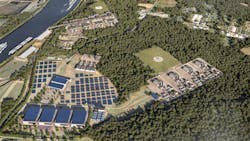Mountaineer to Monarch: Fidelis New Energy's $5B Data Center Plan includes Hydrogen Microgrid in West Virginia
The high energy outlook for future microgrids powered by low or no-carbon hydrogen picked up steam this week with a Houston-based renewable infrastructure firm selecting West Virginia for a new project to power its future data center campus there.
Fidelis New Energy revealed plans to locate its first planned net-zero production facility intended to power and cool its data centers. If realized, the future H2 production site in Mason County, West Virginia, will utilize Fidelis hydrogen production technology to serve the company’s planned Mountaineer Gigasystem and Monarch Cloud Campus sites.
The Fidelis announcement follows another earlier this month by historical oilfield services firm Baker Hughes on its partnership with Avports to develop hydrogen microgrids for airports.
Hydrogen does not contain carbon in its chain and thus does not emit CO2 when combusted. However, several methods of separating H2 from methane gas are more carbon-intensive and would require carbon capture and storage technologies to lower the environmental impact.
To that end, project developers gained an incentive package commitment from the state of West Virginia to research the geologic possibilities for carbon capture and sequestration (CCS) in the region. The FidelisH2 technology would involve hydrogen production using both natural gas and renewable energy resources.
The ultimately $5 billion Mountaineer project, if completed in all four planned phases, could capture and store approximately 10 million metric tons of CO2 per year, according to the company. The Gigasystem project is designed to produce 500 metric tons of H2 per day.
“By combining several proven technologies from leading providers, including our FidelisH2 partners Topsoe and Babcock & Wilcox, we are able to produce lifecycle carbon-free clean hydrogen at scale, without taking new technology risk,” Bengt Jarlsjo, Fidelis co-founder, president and chief operating officer, said in the company release.
“Our proprietary net-zero solutions using only proven technologies are attracting significant commercial interest from hydrogen users, data center operators and greenhouse owners,” Jarlsjo added.
On H2, Data Centers and Future Projects from Microgrid Knowledge
Baker Hughes, Avports sign MoU on Future H2 Microgrids at Airports
Push is on for more Renewables and Microgrids in Virginia's Energy-Hungry Data Center Hub
Once fully built out, the Mountaineer hydrogen production, data center and cloud facilities could reach 1,000 MW (1 GW) in capacity. The planners also hope to use waste heat from the projects as resources for greenhouses to decarbonize nearby food production, according to the release.
Fidelis estimates the annual local financial impact for that region of West Virginia at close to $100 million.
“The project’s four-phase construction plan will not only provide substantial employment opportunities for the local workforce, with 800-full-time jobs and 4,200 construction workers, but it will also have a major positive impact on the region’s economy,” John Musgrave, executive director for the Mason County Development Authority, said in the statement. “The influx of workers and the establishment of the facility will bring additional business, industry and new technology to Mason County, the state and the surrounding region.”
The unemployment rate in West Virginia has improved significantly over the past few years, but it ranked at 3.4 percent—still higher than more than 30 other U.S. states, according to a July report from the federal Bureau of Labor Statistics.
Many companies, states and the current U.S. presidential administration all have long-term goals of reaching net-zero greenhouse gas emissions by 2050 and at least significant decreases in this decade. To do so and also meet the challenges of expansion in electrification, many experts say the power sector will need vast amounts of carbon-free or low-carbon and yet energy-dense resources such as hydrogen and nuclear.
West Virginia is one of the nation’s biggest producers of natural gas, drilled from the prolific Marcellus and Utica shale plays deep beneath the surface. Hydrogen can be generated from the steam reforming and other technologies involving methane gas, although it also can be split from water via electrolysis powered by renewable energy resources, according to reports.
More on Natural Gas and Microgrid Fuels: Simple Concept, Complex Reality
Fidelis New Energy was co-founded by Jarlsjo and CEO Daniel Shapiro. Prior to starting Fidelis, both were co-founders of First Infrastructure Capital Advisors and also were deeply involved in leadership at Quanta Services.
This year alone, Fidelis New Energy has announced CO2 CCS collaborations with partners such as Gas Storage Denmark, Ross Energy and Aelborg Portland. The hydrogen infrastructure deals with Topsoe and Babcock & Wilcox also were announced earlier this year.
The FidelisH2 Alliance, as the partnership program is known, is designed to qualify for the $3 per kilogram hydrogen production tax credit under the U.S. Inflation Reduction Act funding.
Stay connected to Microgrid Knowledge in coming weeks for more on hydrogen microgrids. And check out our running coverage of ongoing microgrid and minigrid projects of all types in our free newsletter.
About the Author
Rod Walton, Microgrid Knowledge Managing Editor
Managing Editor
For Microgrid Knowledge editorial inquiries, please contact Managing Editor Rod Walton at [email protected].
I’ve spent the last 15 years covering the energy industry as a newspaper and trade journalist. I was an energy writer and business editor at the Tulsa World before moving to business-to-business media at PennWell Publishing, which later became Clarion Events, where I covered the electric power industry. I joined Endeavor Business Media in November 2021 to help launch EnergyTech, one of the company’s newest media brands. I joined Microgrid Knowledge in July 2023.
I earned my Bachelors degree in journalism from the University of Oklahoma. My career stops include the Moore American, Bartlesville Examiner-Enterprise, Wagoner Tribune and Tulsa World, all in Oklahoma . I have been married to Laura for the past 33-plus years and we have four children and one adorable granddaughter. We want the energy transition to make their lives better in the future.
Microgrid Knowledge and EnergyTech are focused on the mission critical and large-scale energy users and their sustainability and resiliency goals. These include the commercial and industrial sectors, as well as the military, universities, data centers and microgrids. The C&I sectors together account for close to 30 percent of greenhouse gas emissions in the U.S.
Many large-scale energy users such as Fortune 500 companies, and mission-critical users such as military bases, universities, healthcare facilities, public safety and data centers, shifting their energy priorities to reach net-zero carbon goals within the coming decades. These include plans for renewable energy power purchase agreements, but also on-site resiliency projects such as microgrids, combined heat and power, rooftop solar, energy storage, digitalization and building efficiency upgrades.

